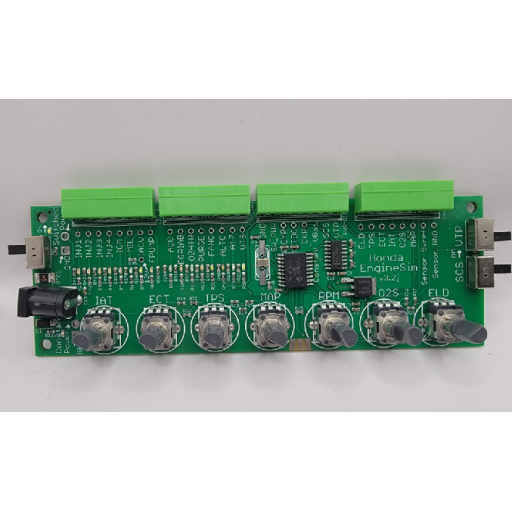New version, It's HERE (feb26-2024)!
OBD1 Honda engine simulator. The OBD1 engine simulator allows running and testing of OBD1 (and other compatible) Honda ECU's directly on the bench. Testing on the bench allows complete testing to verify circuit operation, etc. without ever installing into a vehicle.
This is great to be able to isolate the ECU from a vehicle and test functions of the ECU that would otherwise be able to duplicate or test on the vehicle. The engine simulator is available as a "bare bones" kit with just the board itself, or as a complete kit with power supply and harness with OBD1 ECU plugs attached. The bare bones kit is for those who would like to build their own harness and provide their own power supply, while the complete kit is a quick solution to begin using the simulator as soon as you receive it.
The Honda EngineSim was introduced to allow interactive bench testing of Honda ECUs. It supplies the signals from the distributor and many sensors so that an ECU can be fooled into thinking it has a functioning, running engine connected when it is safely on the bench. Controls are simple: on/off switches and knobs to adjust values up and down. Outputs like injectors, ignition control module (ICM) and solenoids can be observed via LEDs. This provides a means for testing ECUs outside of a vehicle and observing many common faults such as damaged injector drivers, fuel pump drivers and distributor VR sensor amplifier damage. Note: The engine simulator can NOT simulate idle air control valve behavior well enough to avoid a Code 14, so you will always have a code 14 present for the IACV unless disabled in the ROM/program running on the ECU. However, you can observe the dim vs. bright LED for the IACV to visually verify the IACV circuit is working.
The Sim bare kit is supplied without a power supply. The sim has a center-positive 2.1mm barrel jack for power. Alternatively, wires can be soldered to “CONST PWR” and “GND” instead of the barrel jack. There is not a single “right” power adapter for this – you could even use a variable voltage supply to investigate behavior of the ECU under different power conditions. In addition to many “wall wart” style adapters, the 12V rail of an AT/ATX power supply (yellow + black color wires typically) is suitable. If you'd prefer to purchase with a power supply that is ready to use, select the "Engine Sim Plus Power Supply" option.
Power supplied to the sim will be supplied to the ECU, through a diode and PTC fuse. This means that whatever voltage coming in will go out to the ECU, minus 0.6V or so forward voltage (Vf) for a silicon protection diode. i.e. 15V in, 14.4V supply to ECU or 12.0V in, 11.4V supply to ECU. You will make the protection circuitry on the sim unhappy (and hot) supplying more than 17V but unregulated / marginally regulated supplies will work ok – the sim isn’t terribly picky about stable voltage. Maximum current draw for an ECU and all LEDs lit up simultaneously (unlikely scenario) was around 680ma. 400-500ma is a more realistic current draw for sizing purposes.
The PTC fuse on the sim is a thermal fuse. As current goes through it, it gets warmer. As it gets warmer, it’s resistance increases. More power = more heat. Eventually, the PTC fuse will enter a thermal runaway scenario where it cuts off. If you connect an ECU that is shorted out or otherwise drawing an excessive amount of power, you will see the sim “shut down” or all the lights get really dim except for the main power LED that remains lit whenever power is connected to the unit.
The Sim bare kit is supplied without a harness – you must construct your own. The wire harness connections are clearly labeled at each screw terminal location as can be seen on the photos. You will need a set of plugs from a 92-95 Honda Civic, Accord, Prelude, etc. It is recommended but not required to strip the connectors down to only the wires to be connected to the sim, removing any pins that will be unused. In some cases, it may be necessary to add wires to the harness for all Engine Sim functions. If you'd prefer to purchase with a wire harness already built and ready to use, select the "Sim + power supply + harness plugs with pigtails" option. That is the full ready to go option. (Comes with the SIM, Power supply, and Unterminated pigtail/harness - you have to plug into board side connectors that go to sim). NOTE: The current pigtails/harness provided are plugs removed from obd1 vehicles and are calculated cheaper than a manufactured harness would add to the cost.
BoostedNW OBD1 Honda Engine Simulator
- Product Code: boostednw-engine-sim
- Availability: Hurry! Only 5 left in stock!
- $199.99 USD
-
$189.99 USD
Available Options
Tags: sim, simulator, engine sim, moates engine sim, moates, testing
OFF ROAD USE NOTICE
Items sold through boostednw.com including tuning products may be designed for off-road/race use only, and are not applicable for vehicles in states that require pollution controlled vehicles. California (CARB) & other states prohibit the sale or use of some aftermarket parts, including those that tamper with, modify or defeat emissions systems in any 1966 and newer vehicles. BoostedNW LLC prohibits the use of these products on emission controlled vehicles. These parts are sold for OFF ROAD, RACE-ONLY, ground-vehicle use only in a controlled environment.
BoostedNW LLC does not implicitly or explicitly confirm the legality of using any products it sells on public roads. Customers are solely responsible for ensuring all products purchased are used in a legal manner.

